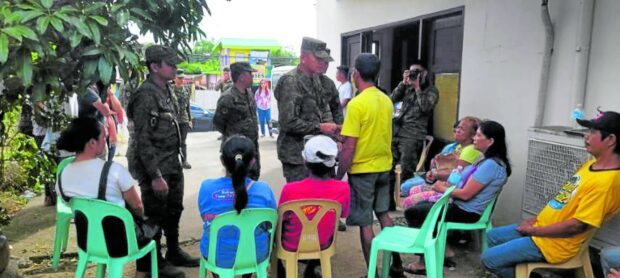
IN MOURNING | Maj. Gen. Roberto Capulong, commander of the Army’s 2nd Infantry Division handling anti-insurgency operations in Calabarzon, condoles with and provides financial aid to the families of the five militiamen who were killed by suspected communist rebels in Tagkawayan, Quezon, on Sept. 1, 2023 (Photo from the 85th Infantry Battalion)
LUCENA CITY, Quezon, Philippines — Quezon province has seemingly lost its “insurgency-free” tag after New People’s Army (NPA) rebels staged an attack that left five government militiamen dead and three others wounded in Tagkawayan town on Friday.
According to Marco Valbuena, Communist Party of the Philippines (CPP) public information officer, the assault was carried out by Red fighters from the NPA’s Apolonio Mendoza Command (APC) based in the province.
Valbuena scoffed at the police and military intelligence units in the province for claiming that the attack was conducted by NPA rebels based in Camarines Norte province and not in Quezon.
“The ambush was a big slap on their face after they declared that Quezon is now insurgency-free,” Valbuena said in a statement released on Saturday.
Valbuena said the attack “clearly proves in action the hollow declarations of the AFP [Armed Forces of the Philippines] and Marcos regime of crushing the NPA.”
On Friday, police and military reported that a band of communist guerrillas from the Bicol region attacked a team of Civilian Armed Force Geographical Unit (Cafgu) and Army soldiers who were about to conduct a patrol in Sitio Pagasa in Barangay Mapulot at around 7 a.m. The battle site was about 500 meters away from the boundary of Tagkawayan and the town of Labo in Camarines Norte.
The five Cafgu members killed during the assault were Cesar Sales, Jeffrey San Antonio, Aldon James Rapa, Johnwell Perez, and Jomari Guno, all residents of Tagkawayan.
Two other militiamen, Lauro de Guzman and Regie Macalintal, and one soldier, Cpl. Marvijun Oller Jr. from the Army’s 85th Infantry Battalion, were wounded during the battle.
‘No more men’
But Police Col. Ledon Monte, Quezon provincial police chief, refuted Valbuena’s claim that the assault was staged by local communist guerrillas.
Monte said the NPA’s Southern Tagalog Regional Party Committee, particularly the APC, “have no more men” to wage an assault.
“It is expected that they (APC) will claim responsibility for the attack and shield the BRPC (Bicol Regional Party Committee),” Monte said in an online interview on Sunday.
Army Col. Dennis Cana, Armed Forces Southern Luzon Command public information officer, also believed that the Bicol-based NPA members were involved.
“The remnants of the NPA in Quezon probably joined forces with the main attacking force from Bicol,” Cana said in a separate online interview on Sunday.
He said that after the attack, the NPA rebels retreated toward Camarines Norte “because they know that they are not welcome in Quezon.”
Monte said one of the militiamen stepped on an explosive device planted by the NPA rebels.
“It was a direct hit,” Monte said in a phone interview on Friday.
In a separate statement, Ka Cleo del Mundo, spokesperson of the NPA’s APC, claimed that the attackers recovered five high-powered firearms from the government forces after the battle that lasted for more than one hour.
“The tactical offensive proves that the NPA remains in the province of Quezon. We cannot be defeated,” he boasted.
Signal
Del Mundo warned that the attack was “a signal and an opening for the upcoming tactical offensives across the entire province.”
Last June, local government, police, and military officials in Quezon declared the province free from the influence of communist insurgents.
They said the province had attained “Stable Internal Peace and Security” or SIPS status, which means that the CPP, the National Democratic Front of the Philippines, and the NPA are no longer a threat to the peace and order in its localities.
Since March this year, the police and the military have not reported clashes in the province but only “mass surrenders” of NPA rebels and their allied militia members and supporters.